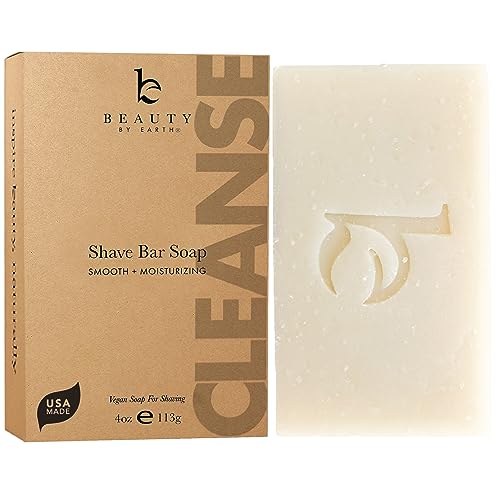


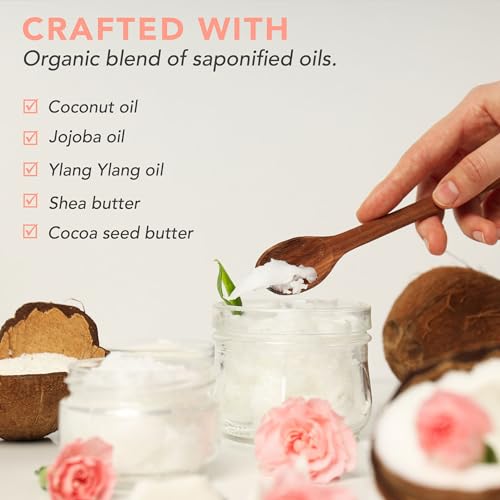
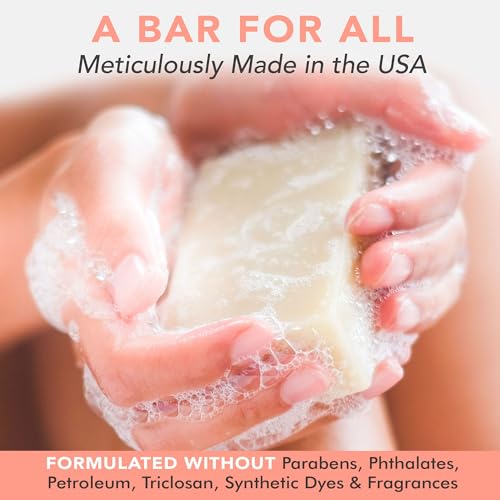
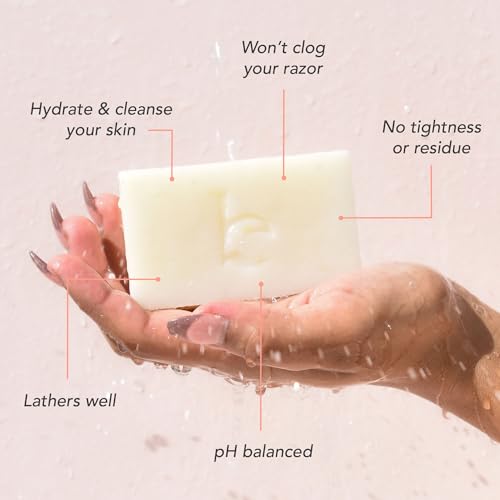
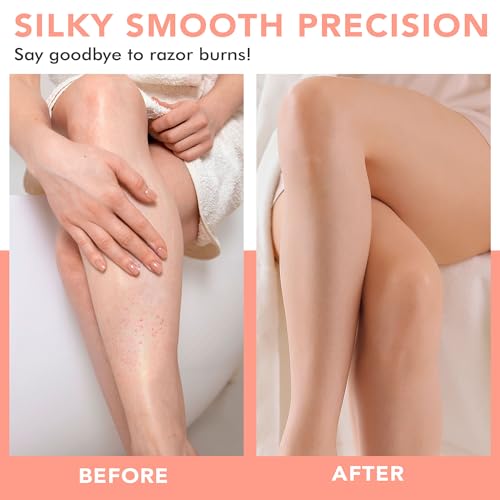


Beauty by Earth Organic Bar Soap - Moisturizing Shave Bar, Natural Ingredients, Handmade - 4oz


Cananga Odorata (Ylang Ylang) Oil
High RiskCananga odorata (ylang ylang) oil is an essential oil derived from the flowers of the ylang ylang tree. It is primarily used in cosmetic and fragrance formulations for its aromatic properties and as a fixative in perfumes.
Sustai Insights
Ylang ylang oil offers functional benefits as a fragrance and fixative, with potential sustainability credentials depending on sourcing practices. However, it has a high allergenic potential, posing risks of skin irritation and sensitization. Regulatory bodies have noted restrictions on its use in certain products. Overall, the ingredient presents a high risk due to health concerns and potential exposure from multiple sources.
Cymbopogon (Lemon Grass) Oil
High RiskCymbopogon (lemongrass) oil is an essential oil derived from the leaves and stalks of lemongrass plants. It is primarily used for its aromatic properties in cosmetics and personal care products, serving as a fragrance component and potential antimicrobial agent.
Sustai Insights
Lemongrass oil offers functional benefits as a natural fragrance and antimicrobial agent. However, it has a high allergenic potential, which may cause skin sensitization or irritation. Environmental concerns include possible irritation to aquatic life if released into water systems. Regulatory bodies advise caution due to its enhanced skin absorption properties. Overall, the ingredient presents a high-risk profile, necessitating careful consideration in formulation. Safer alternatives may include synthetic fragrances or other essential oils with lower allergenic profiles.
Cymbopogon Schoenanthus Oil
High RiskCymbopogon schoenanthus oil is a volatile oil derived from the leaves of the lemongrass plant, commonly used for its aromatic properties in cosmetics and personal care products. It serves primarily as a fragrance component but may also have antimicrobial properties.
Sustai Insights
Cymbopogon schoenanthus oil offers functional benefits as a fragrance and may contribute antimicrobial properties. However, it has a high allergenic potential, with concerns regarding enhanced skin absorption and potential irritancy. Regulatory bodies have imposed usage restrictions due to these risks. Overall, the ingredient presents a high risk level, necessitating caution in its application, especially for sensitive populations. Alternatives with lower allergenic profiles could be considered in formulation.
Pogostemon Cablin (Patchouli) Oil
High RiskPogostemon cablin (patchouli) oil is a volatile oil obtained from the leaves of the patchouli plant. It is commonly used in cosmetic formulations for its fragrance and potential skin benefits.
Sustai Insights
Pogostemon cablin oil offers functional benefits as a fragrance and potential antimicrobial agent. However, it is associated with a high risk of allergenic reactions and may cause skin irritation. Regulatory agencies have noted restrictions on its use in certain products. Environmentally, it poses risks as a potential pollutant. Overall, the ingredient is assessed to have a high risk level, and caution is advised in its use, with consideration for alternatives that may be safer or more sustainable.
Vetiveria Zizanioides Root Oil
Medium RiskVetiveria zizanioides root oil is a volatile oil derived from the roots of the vetiver plant. It is primarily used for its aromatic properties in perfumes and cosmetics, as well as for its potential therapeutic benefits in aromatherapy and traditional medicine.
Sustai Insights
Vetiveria zizanioides root oil offers functional benefits as a fragrance and may have calming effects in aromatherapy. It is generally considered low risk for carcinogenicity and developmental toxicity but poses moderate concerns for allergies. Environmentally, it is not known to be bioaccumulative, and its production is often sustainable. Regulatory statuses are favorable, with no current restrictions. Overall, while it has beneficial properties, the moderate allergy risk necessitates caution in sensitive populations, leading to a medium risk assessment.
Cedrus Atlantica (Atlas Cedar) Oil
Medium RiskCedrus atlantica (Atlas cedar) oil is an essential oil derived from the wood of the Atlas cedar tree. It is primarily used for its aromatic properties in personal care products and fragrances, offering a woody scent that is often associated with calming effects.
Sustai Insights
While Cedrus atlantica oil offers functional benefits such as fragrance and possible antimicrobial effects, it is associated with high allergenic potential, which may trigger skin irritations or sensitivities in some individuals. Environmental risks include its potential as a pollutant if not sourced sustainably. Regulatory bodies have placed restrictions on its use in certain products, marking it with a medium risk level overall. Safe usage practices should be observed to minimize exposure, and alternatives such as synthetic fragrances or other essential oils may be considered for those with sensitivities.
Rosmarinus Officinalis (Rosemary) Leaf Extract
Medium RiskRosemary leaf extract is produced from the leaves of the Rosmarinus officinalis plant. It is commonly used in cosmetic formulations for its potential antioxidant properties and fragrance. The extract may also contribute to the preservation of products due to its antimicrobial characteristics.
Sustai Insights
Rosemary leaf extract offers functional benefits such as antioxidant and antimicrobial properties, which can enhance product stability and shelf-life. It is generally considered low risk for carcinogenicity and reproductive toxicity, but it carries a moderate potential for allergic reactions. Environmentally, it poses low risk with no significant pollutant or bioaccumulation concerns. Regulatory bodies have not placed significant restrictions on its use, although some verified products cannot contain certain concentrations. Overall, the ingredient's risk level is medium, necessitating careful usage practices to mitigate allergic responses.
Carthamus Tinctorius (Safflower) Seed Oil
Low RiskCarthamus tinctorius (safflower) seed oil is derived from the seeds of the safflower plant. It is primarily used in cosmetic formulations for its emollient properties, helping to moisturize and soften the skin. The oil is rich in unsaturated fatty acids and is often employed in skin care products for its potential benefits to skin health.
Sustai Insights
Safflower seed oil offers functional benefits as a moisturizer and emollient, contributing to skin hydration without significant irritation. It is generally recognized as low risk concerning health impacts, with minimal concerns over carcinogenicity, allergies, and reproductive toxicity. Environmentally, it poses low risks, being non-bioaccumulative and not a significant pollutant. Regulatory bodies do not impose restrictions on its use, underscoring its safety profile. While there are no widely recognized safer alternatives, users should ensure proper application to mitigate any potential skin irritation. Overall, this ingredient is assessed as low risk.
Cocoa
Low RiskCocoa is derived from the beans of the cacao tree (Theobroma cacao) and is primarily used for its flavor and antioxidant properties in various products, including food and cosmetics. It functions as an emollient and provides a rich, chocolate scent.
Sustai Insights
Cocoa offers functional benefits such as antioxidant properties and moisturizing effects in cosmetic applications. It is generally considered safe, showing low concerns for carcinogenicity, allergies, and reproductive toxicity. While cocoa is not known to contribute significantly to environmental pollution, its cultivation can impact biodiversity. Regulatory bodies do not impose significant restrictions on cocoa. Overall, the ingredient is assessed to have a low risk profile, making it a suitable choice in formulations.
Elaeis Guineensis (Palm) Kernel Oil
Low RiskElaeis guineensis (palm) kernel oil is an oil derived from the seeds of the African oil palm tree. It functions primarily as an emollient and moisturizing agent in cosmetic formulations, enhancing texture and providing moisture retention.
Sustai Insights
Elaeis guineensis (palm) kernel oil offers functional benefits as a moisturizing agent and is often sustainably sourced. Health risks are low, with minimal concerns regarding carcinogenicity, allergies, or reproductive toxicity. Environmental risks appear low, with no significant pollutant or bioaccumulation issues reported. Regulatory bodies impose few restrictions, suggesting overall low risk. Safe usage practices recommend using it within established concentrations, while alternatives such as coconut oil may be considered for similar functions. Overall, this ingredient presents a low risk profile.
Lavandula Angustifolia (Lavender) Oil
Low RiskLavandula angustifolia (lavender) oil is a volatile oil derived from the flowers of the lavender plant. It is commonly used in cosmetic and personal care products for its fragrance and potential calming properties.
Sustai Insights
Lavender oil offers functional benefits such as providing fragrance and potential relaxation effects. It is biodegradable and often sustainably sourced. Health risks are minimal, with low concerns for carcinogenicity, allergies, or reproductive toxicity; however, there is a low to moderate concern regarding endocrine disruption. Environmental risks are low, with no significant pollutant or bioaccumulation potential noted. Regulatory status is favorable, with no current restrictions. Safe usage practices include avoiding excessive concentrations, especially in sensitive applications. Overall, the risk level associated with lavender oil is assessed as low.
Cocos Nucifera (Coconut) Oil
Low RiskCocos Nucifera (Coconut) Oil is derived from the kernels of the coconut palm. It is primarily used in cosmetic formulations for its emollient and moisturizing properties, making it suitable for skin and hair care products.
Sustai Insights
Coconut oil serves as an effective moisturizer and emollient, promoting skin hydration and softness. It is sustainably sourced and biodegradable. Health risks are minimal, with low concerns regarding carcinogenicity, allergens, and reproductive toxicity. Environmental impact is also low, as it does not contribute significantly to pollution or bioaccumulation. Regulatory bodies have not issued restrictions on its use. Overall, coconut oil presents a low risk for health and environmental concerns, making it a safe ingredient in cosmetic products.
Butyrospermum Parkii (Shea) Butter
Low RiskButyrospermum parkii (shea) butter is a vegetable fat derived from the nuts of the shea tree. It is commonly used in cosmetic formulations for its emollient properties, providing moisture and improving skin texture. Additionally, shea butter is known for its ability to enhance the stability of products and deliver a creamy texture.
Sustai Insights
Shea butter offers functional benefits as an effective moisturizer, enhancing skin barrier function and texture. It is sustainably sourced and biodegradable, contributing to eco-friendliness. Health-wise, it is associated with low risks for carcinogenicity, allergies, and reproductive toxicity. Environmental impacts are minimal, with no significant pollutant potential identified. Regulatory assessments indicate no current restrictions. Overall, the ingredient presents a low risk, making it a favorable choice in cosmetic formulations.
Helianthus Annuus (Sunflower) Seed Oil
Low RiskHelianthus annuus (sunflower) seed oil is derived from the seeds of the sunflower plant. It serves primarily as an emollient and moisturizer in cosmetic formulations, helping to maintain skin hydration and improve texture.
Sustai Insights
Sunflower seed oil is effective as an emollient, providing moisture and improving skin texture while being biodegradable and sustainably sourced. It poses low health risks, including negligible concerns for carcinogenicity, allergies, or reproductive toxicity. Environmentally, it does not significantly contribute to pollution or bioaccumulation. Regulatory bodies currently do not list any advisories for this ingredient. Overall, it is assessed as low risk, with safe usage practices recommended. Alternatives include oils like jojoba or almond oil for those seeking different properties.
Simmondsia Chinensis (Jojoba) Seed Oil
Low RiskSimmondsia chinensis (jojoba) seed oil is extracted from the seeds of the jojoba plant. It is commonly used in cosmetics for its moisturizing properties and ability to mimic human sebum, making it beneficial for skin and hair care formulations.
Sustai Insights
Jojoba seed oil offers functional benefits such as effective moisturization and emollience, contributing to skin hydration and smoothness. It is sustainably sourced and biodegradable. Health risks are low, with minimal concerns regarding carcinogenicity, allergies, and reproductive toxicity. Environmental risks are also low, as it does not significantly contribute to pollution or bioaccumulation. Currently, there are no regulatory restrictions on its use. Overall, the risk level is low, and it is considered a safe ingredient with no significant adverse effects.
Vetiveria Zizanioides Root Oil
Medium RiskVetiveria zizanioides root oil is a volatile oil derived from the roots of the vetiver plant. It is primarily used for its aromatic properties in perfumes and cosmetics, as well as for its potential therapeutic benefits in aromatherapy and traditional medicine.
Sustai Insights
Vetiveria zizanioides root oil offers functional benefits as a fragrance and may have calming effects in aromatherapy. It is generally considered low risk for carcinogenicity and developmental toxicity but poses moderate concerns for allergies. Environmentally, it is not known to be bioaccumulative, and its production is often sustainable. Regulatory statuses are favorable, with no current restrictions. Overall, while it has beneficial properties, the moderate allergy risk necessitates caution in sensitive populations, leading to a medium risk assessment.
Carthamus Tinctorius (Safflower) Seed Oil
Low RiskCarthamus tinctorius (safflower) seed oil is derived from the seeds of the safflower plant. It is primarily used in cosmetic formulations for its emollient properties, helping to moisturize and soften the skin. The oil is rich in unsaturated fatty acids and is often employed in skin care products for its potential benefits to skin health.
Sustai Insights
Safflower seed oil offers functional benefits as a moisturizer and emollient, contributing to skin hydration without significant irritation. It is generally recognized as low risk concerning health impacts, with minimal concerns over carcinogenicity, allergies, and reproductive toxicity. Environmentally, it poses low risks, being non-bioaccumulative and not a significant pollutant. Regulatory bodies do not impose restrictions on its use, underscoring its safety profile. While there are no widely recognized safer alternatives, users should ensure proper application to mitigate any potential skin irritation. Overall, this ingredient is assessed as low risk.
Cananga Odorata (Ylang Ylang) Oil
High RiskCananga odorata (ylang ylang) oil is an essential oil derived from the flowers of the ylang ylang tree. It is primarily used in cosmetic and fragrance formulations for its aromatic properties and as a fixative in perfumes.
Sustai Insights
Ylang ylang oil offers functional benefits as a fragrance and fixative, with potential sustainability credentials depending on sourcing practices. However, it has a high allergenic potential, posing risks of skin irritation and sensitization. Regulatory bodies have noted restrictions on its use in certain products. Overall, the ingredient presents a high risk due to health concerns and potential exposure from multiple sources.
Cocoa
Low RiskCocoa is derived from the beans of the cacao tree (Theobroma cacao) and is primarily used for its flavor and antioxidant properties in various products, including food and cosmetics. It functions as an emollient and provides a rich, chocolate scent.
Sustai Insights
Cocoa offers functional benefits such as antioxidant properties and moisturizing effects in cosmetic applications. It is generally considered safe, showing low concerns for carcinogenicity, allergies, and reproductive toxicity. While cocoa is not known to contribute significantly to environmental pollution, its cultivation can impact biodiversity. Regulatory bodies do not impose significant restrictions on cocoa. Overall, the ingredient is assessed to have a low risk profile, making it a suitable choice in formulations.
Elaeis Guineensis (Palm) Kernel Oil
Low RiskElaeis guineensis (palm) kernel oil is an oil derived from the seeds of the African oil palm tree. It functions primarily as an emollient and moisturizing agent in cosmetic formulations, enhancing texture and providing moisture retention.
Sustai Insights
Elaeis guineensis (palm) kernel oil offers functional benefits as a moisturizing agent and is often sustainably sourced. Health risks are low, with minimal concerns regarding carcinogenicity, allergies, or reproductive toxicity. Environmental risks appear low, with no significant pollutant or bioaccumulation issues reported. Regulatory bodies impose few restrictions, suggesting overall low risk. Safe usage practices recommend using it within established concentrations, while alternatives such as coconut oil may be considered for similar functions. Overall, this ingredient presents a low risk profile.
Cedrus Atlantica (Atlas Cedar) Oil
Medium RiskCedrus atlantica (Atlas cedar) oil is an essential oil derived from the wood of the Atlas cedar tree. It is primarily used for its aromatic properties in personal care products and fragrances, offering a woody scent that is often associated with calming effects.
Sustai Insights
While Cedrus atlantica oil offers functional benefits such as fragrance and possible antimicrobial effects, it is associated with high allergenic potential, which may trigger skin irritations or sensitivities in some individuals. Environmental risks include its potential as a pollutant if not sourced sustainably. Regulatory bodies have placed restrictions on its use in certain products, marking it with a medium risk level overall. Safe usage practices should be observed to minimize exposure, and alternatives such as synthetic fragrances or other essential oils may be considered for those with sensitivities.
Rosmarinus Officinalis (Rosemary) Leaf Extract
Medium RiskRosemary leaf extract is produced from the leaves of the Rosmarinus officinalis plant. It is commonly used in cosmetic formulations for its potential antioxidant properties and fragrance. The extract may also contribute to the preservation of products due to its antimicrobial characteristics.
Sustai Insights
Rosemary leaf extract offers functional benefits such as antioxidant and antimicrobial properties, which can enhance product stability and shelf-life. It is generally considered low risk for carcinogenicity and reproductive toxicity, but it carries a moderate potential for allergic reactions. Environmentally, it poses low risk with no significant pollutant or bioaccumulation concerns. Regulatory bodies have not placed significant restrictions on its use, although some verified products cannot contain certain concentrations. Overall, the ingredient's risk level is medium, necessitating careful usage practices to mitigate allergic responses.
Cymbopogon (Lemon Grass) Oil
High RiskCymbopogon (lemongrass) oil is an essential oil derived from the leaves and stalks of lemongrass plants. It is primarily used for its aromatic properties in cosmetics and personal care products, serving as a fragrance component and potential antimicrobial agent.
Sustai Insights
Lemongrass oil offers functional benefits as a natural fragrance and antimicrobial agent. However, it has a high allergenic potential, which may cause skin sensitization or irritation. Environmental concerns include possible irritation to aquatic life if released into water systems. Regulatory bodies advise caution due to its enhanced skin absorption properties. Overall, the ingredient presents a high-risk profile, necessitating careful consideration in formulation. Safer alternatives may include synthetic fragrances or other essential oils with lower allergenic profiles.
Cymbopogon Schoenanthus Oil
High RiskCymbopogon schoenanthus oil is a volatile oil derived from the leaves of the lemongrass plant, commonly used for its aromatic properties in cosmetics and personal care products. It serves primarily as a fragrance component but may also have antimicrobial properties.
Sustai Insights
Cymbopogon schoenanthus oil offers functional benefits as a fragrance and may contribute antimicrobial properties. However, it has a high allergenic potential, with concerns regarding enhanced skin absorption and potential irritancy. Regulatory bodies have imposed usage restrictions due to these risks. Overall, the ingredient presents a high risk level, necessitating caution in its application, especially for sensitive populations. Alternatives with lower allergenic profiles could be considered in formulation.
Lavandula Angustifolia (Lavender) Oil
Low RiskLavandula angustifolia (lavender) oil is a volatile oil derived from the flowers of the lavender plant. It is commonly used in cosmetic and personal care products for its fragrance and potential calming properties.
Sustai Insights
Lavender oil offers functional benefits such as providing fragrance and potential relaxation effects. It is biodegradable and often sustainably sourced. Health risks are minimal, with low concerns for carcinogenicity, allergies, or reproductive toxicity; however, there is a low to moderate concern regarding endocrine disruption. Environmental risks are low, with no significant pollutant or bioaccumulation potential noted. Regulatory status is favorable, with no current restrictions. Safe usage practices include avoiding excessive concentrations, especially in sensitive applications. Overall, the risk level associated with lavender oil is assessed as low.
Pogostemon Cablin (Patchouli) Oil
High RiskPogostemon cablin (patchouli) oil is a volatile oil obtained from the leaves of the patchouli plant. It is commonly used in cosmetic formulations for its fragrance and potential skin benefits.
Sustai Insights
Pogostemon cablin oil offers functional benefits as a fragrance and potential antimicrobial agent. However, it is associated with a high risk of allergenic reactions and may cause skin irritation. Regulatory agencies have noted restrictions on its use in certain products. Environmentally, it poses risks as a potential pollutant. Overall, the ingredient is assessed to have a high risk level, and caution is advised in its use, with consideration for alternatives that may be safer or more sustainable.
Cocos Nucifera (Coconut) Oil
Low RiskCocos Nucifera (Coconut) Oil is derived from the kernels of the coconut palm. It is primarily used in cosmetic formulations for its emollient and moisturizing properties, making it suitable for skin and hair care products.
Sustai Insights
Coconut oil serves as an effective moisturizer and emollient, promoting skin hydration and softness. It is sustainably sourced and biodegradable. Health risks are minimal, with low concerns regarding carcinogenicity, allergens, and reproductive toxicity. Environmental impact is also low, as it does not contribute significantly to pollution or bioaccumulation. Regulatory bodies have not issued restrictions on its use. Overall, coconut oil presents a low risk for health and environmental concerns, making it a safe ingredient in cosmetic products.
Butyrospermum Parkii (Shea) Butter
Low RiskButyrospermum parkii (shea) butter is a vegetable fat derived from the nuts of the shea tree. It is commonly used in cosmetic formulations for its emollient properties, providing moisture and improving skin texture. Additionally, shea butter is known for its ability to enhance the stability of products and deliver a creamy texture.
Sustai Insights
Shea butter offers functional benefits as an effective moisturizer, enhancing skin barrier function and texture. It is sustainably sourced and biodegradable, contributing to eco-friendliness. Health-wise, it is associated with low risks for carcinogenicity, allergies, and reproductive toxicity. Environmental impacts are minimal, with no significant pollutant potential identified. Regulatory assessments indicate no current restrictions. Overall, the ingredient presents a low risk, making it a favorable choice in cosmetic formulations.
Helianthus Annuus (Sunflower) Seed Oil
Low RiskHelianthus annuus (sunflower) seed oil is derived from the seeds of the sunflower plant. It serves primarily as an emollient and moisturizer in cosmetic formulations, helping to maintain skin hydration and improve texture.
Sustai Insights
Sunflower seed oil is effective as an emollient, providing moisture and improving skin texture while being biodegradable and sustainably sourced. It poses low health risks, including negligible concerns for carcinogenicity, allergies, or reproductive toxicity. Environmentally, it does not significantly contribute to pollution or bioaccumulation. Regulatory bodies currently do not list any advisories for this ingredient. Overall, it is assessed as low risk, with safe usage practices recommended. Alternatives include oils like jojoba or almond oil for those seeking different properties.
Simmondsia Chinensis (Jojoba) Seed Oil
Low RiskSimmondsia chinensis (jojoba) seed oil is extracted from the seeds of the jojoba plant. It is commonly used in cosmetics for its moisturizing properties and ability to mimic human sebum, making it beneficial for skin and hair care formulations.
Sustai Insights
Jojoba seed oil offers functional benefits such as effective moisturization and emollience, contributing to skin hydration and smoothness. It is sustainably sourced and biodegradable. Health risks are low, with minimal concerns regarding carcinogenicity, allergies, and reproductive toxicity. Environmental risks are also low, as it does not significantly contribute to pollution or bioaccumulation. Currently, there are no regulatory restrictions on its use. Overall, the risk level is low, and it is considered a safe ingredient with no significant adverse effects.
Experience the luxurious touch of Beauty by Earth Organic Bar Soap, an all-in-one solution for your skincare and shaving needs. This rich, foamy lather cleanses, moisturizes, and soothes, making it perfect for those seeking a natural and eco-friendly alternative.
- Natural Ingredients: Made with organic Shea Butter, Lavender, and Lemongrass oils, this soap offers deep hydration without harsh chemicals, ensuring gentle care for your skin.
- Dual Purpose: Use it as a shaving cream to achieve a smooth, irritation-free shave, leaving your skin matte and radiant post-use.
- Handmade Quality: Crafted in small batches in the USA, this cruelty-free soap is a testament to ethical production practices and quality craftsmanship.
- Sulfate & Paraben Free: Enjoy peace of mind knowing your soap is free from harmful additives, making it ideal for sensitive skin.
- Satisfaction Guaranteed: With a commitment to customer happiness, your satisfaction is prioritized, offering a risk-free experience with every purchase.
Subscribe & Save with Sustai
- Best Price Guarantee: Always enjoy the lowest prices on sustainable home essentials.
- No Surprises: We’ll notify you before shipping. No hidden fees, ever.
- You’re in Charge: Change, pause, or cancel your subscription anytime with ease.
- Eco-Friendly Deliveries: Our grouped shipments mean less packaging and lower emissions.
Join us on a sustainable journey. Special offers for a limited time! Prices and promotions may change.
Recommended Products
Experience the luxurious touch of Beauty by Earth Organic Bar Soap, an all-in-one solution for your skincare and shaving needs. This rich, foamy lather cleanses, moisturizes, and soothes, making it perfect for those seeking a natural and eco-friendly alternative.
- Natural Ingredients: Made with organic Shea Butter, Lavender, and Lemongrass oils, this soap offers deep hydration without harsh chemicals, ensuring gentle care for your skin.
- Dual Purpose: Use it as a shaving cream to achieve a smooth, irritation-free shave, leaving your skin matte and radiant post-use.
- Handmade Quality: Crafted in small batches in the USA, this cruelty-free soap is a testament to ethical production practices and quality craftsmanship.
- Sulfate & Paraben Free: Enjoy peace of mind knowing your soap is free from harmful additives, making it ideal for sensitive skin.
- Satisfaction Guaranteed: With a commitment to customer happiness, your satisfaction is prioritized, offering a risk-free experience with every purchase.

You can have at most 2 Sustainable Steals products in your cart
Customer Reviews
Customers’ View
Customers appreciate the effectiveness and eco-friendly nature of this organic bar soap, which serves both as a shaving aid and a cleansing soap. Many users report a smooth and close shave, highlighting that it is gentle on sensitive skin and reduces irritation, with one customer noting, 'He felt just a tingle and no burn.' The natural ingredients, including essential oils and unrefined shea butter, resonate with health-conscious consumers. Additionally, users value the product's handmade quality and commitment to cruelty-free practices. However, there are some concerns regarding the plastic packaging, as one reviewer expressed disappointment about the unnecessary plastic wrap. Overall, customers find this product effective and aligned with their sustainable lifestyle choices.
AI-generated from the text of customer reviewsThis product has no reviews yet.




